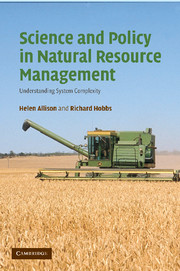Book contents
- Frontmatter
- Contents
- List of illustrations
- List of tables
- Foreword
- Preface
- Acknowledgements
- List of abbreviations
- 1 Introduction
- 2 Historical and policy context
- 3 Natural resource degradation: a resistant problem of the twentieth century
- 4 The epistemology of natural resource management of the twentieth century
- 5 A contemporary epistemology and framework for natural resource management of the twenty-first century
- 6 Model conceptualisation of the Western Australian agricultural region. Part 1: resilience analysis
- 7 Model conceptualisation of the Western Australian agricultural region. Part 2: system dynamics
- 8 Synthesis
- Epilogue
- Glossary
- References
- Index
Preface
Published online by Cambridge University Press: 01 March 2010
- Frontmatter
- Contents
- List of illustrations
- List of tables
- Foreword
- Preface
- Acknowledgements
- List of abbreviations
- 1 Introduction
- 2 Historical and policy context
- 3 Natural resource degradation: a resistant problem of the twentieth century
- 4 The epistemology of natural resource management of the twentieth century
- 5 A contemporary epistemology and framework for natural resource management of the twenty-first century
- 6 Model conceptualisation of the Western Australian agricultural region. Part 1: resilience analysis
- 7 Model conceptualisation of the Western Australian agricultural region. Part 2: system dynamics
- 8 Synthesis
- Epilogue
- Glossary
- References
- Index
Summary
‘I strongly advise you to stay within the discipline’ was the advice from the Head of School in the mid 1970s, when the first author Helen Allison was proposing to take a course in History and Philosophy of Science, conducted in another department, as an option in her Zoology Honours year at Aberdeen University. The reason she was told was that timetabling was difficult and it couldn't be done. In retrospect confining her education to the accepted scientific paradigm would preserve the credibility of the established set of protocols proposed by the zoology discipline thus avoiding any potential for her to ask probing questions on theoretical issues, controversies and paradoxes.
Now 30 years later this book is the result of a course-altering event during the research for a Ph.D. dissertation by Helen, when she discovered an alternative to reductionism. On reading the book Complexity: The Emerging Science at the Edge of Order and Chaos (Waldrop, 1992) Helen wondered why she had not been exposed much earlier in her career to the integrating ideas of complexity and self-organising adaptive systems. However, on reflection it is not surprising, given the tacit agreement and protocols of the scientific paradigm. Helen is grateful to the author M. Waldrop who introduced her to the new sciences for the twenty-first century.
Now it is becoming acceptable to talk about diverse epistemologies, different ways of understanding the world, alternative worldviews and different ways of investigation. We now recognise that the complex problems of human societies require new approaches in science to understand the fundamental drivers of their dynamics and to be able to intervene with appropriate policies.
- Type
- Chapter
- Information
- Science and Policy in Natural Resource ManagementUnderstanding System Complexity, pp. xix - xxPublisher: Cambridge University PressPrint publication year: 2006

